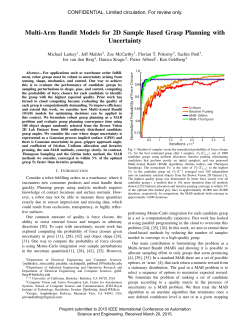
Fiscal Gas Metering
Fiscal Gas Metering presented by Mr. Rune Øverland, Trainor Elsikkerhet AS 1 What is it? • It’s a computer based training course • Accessible from www.nfogm.no • Free of charge • Offered for two knowledge levels 2 Who were involved in the development of the course? Client: Contractor: Supported by: Einar Thorén/Rune Øverland Sub Contractors: Pål Verner Viken Reference Group: Dag Hendrik Kjell-Eivind Frøysa Simon Fellows Flølo, Per Lunde and Steinar Vervik 3 Who are target personnel? Level 1 Level 2 • Personnel operating the measurement stations • Engineers (design, verification, validating) • Administrative personnel • Maintenance personnel (calibration, maintenance, quality checks) What are the course objectives? Level 1 (2 hours) • Introduction to influencing parameters • Measurement regulation • Main components of measurement stations Level 2 (4 hours) • In addition to level 1: • Influencing parameters • Design of measurement stations • NORSOK I-106, ISO standards, AGA reports Course content M0: M1: M2: M3: M4: M5: M6: Course introduction Definitions Regulation and standards Gas dynamics, flow profiles System considerations Flow meters Calibration of flow meters M7: Secondary measurements M8: Sampling systems M9: Gas chromatographs M10: Fiscal gas calculations M11: Gas computer systems M12: NFOGM Uncertainty tool M13: Final assessment 6 How to take the course. You are free to select either Free navigation: • No log on necessary • You can navigate freely in the course. • No final assessment Structured training course: • Log on necessary • You follow a structured path of learning and exercise steps • You can exit at any time to continue later on • Final assessment and course certificate 7 Helpful navigation tools. • Navigation Button: selects a Module • Menu Button: selects a Step within a module 8 How to make the most of it. • Combine the training course with documentation www.nfogm.no www.npd.no NORSOK I-106 www.standard.no ISO 9 Still need help? • Help: Buttons and navigation • Help: Exercize • Info: Documentation 10 Module 0: Course introduction • Navigation technics • Course objectives • Working practice • Documentation • Terminology 11 Module 1: Definitions • Definition of terminologies • Examples: • Temperature, pressure, density • Ideal and real gases • Energy flow rates • CO2 emission factor • Repeatability, reproducibility, random error, uncertainty 12 Module 2: Regulations and Standards • Norwegian Petroleum Directorate: The Measurement regulations • Chapter 1 to 8 • Remarks to Chapter 1 to 8 • CO2-tax act • NORSOK I-106 (Nov 2014) 13 Module 3: Gas dynamics, Flow profiles • Compressible flows • Flow velocity profiles • Gas laws • Standard volume flow rate • Mass flow rate • Calorific value • Energy flow rate 14 Module 5: Flow meters • Ultrasonic Flow meter, turbine flow meter, Coriolis mass meter, Differential pressure elements (Orifice, Venturi and Cone) • Installation, Principle of measurement, influencing parameters, NPD requirements, standards and guidelines 15 Module 6: Calibration of flow meters • Ultrasonic Flow meter (ISO 17089) • Coriolis mass meter (ISO 10790) • Differential pressure elements (ISO 5167) • Laboratory flow calibration, calibration certificate, from Lab to Field, recalibration, type testing 16 Module 7: Secondary measurements (temperature, pressure, density) • Temperature: Pt100 element • Static and differential pressure: Capacitive sensor element • Densitometer: vibrating element • Principle of measurement, requirements, installation, calibration 17 Module 8: Sampling systems • Requirements • Principles of sampling methods • Spot sampling • Incremental sampling • Direct sampling • Sample frequency • Isothermal expansion 18 Module 9: Gas chromatograph • Requirements • Principles of separation Retention time, eddy diffusion • Main components • Carrier gas, Injection valve, Columns, detectors, • Chromatogram • Calibration • Combines uncertainty • Repeatability, linearity, uncertainty calibration gas 19 Module 10: Fiscal gas calculations • Gas parameters • Relevant standards, compressibility factor, density, calorific value, CO2 emission factor • Volume based flow meters • Mass based flow meters • Differential pressure based flow meters • Accumulated values • CO2 reports 20 Module 11: Fiscal gas computer systems • The Measurements regulation • • • • Flow Computer design Supervisory system Alarms and events Provisions for gas metering stations 21 Module 12: NFOGM tool for uncertainty calculations • NFOGM tool web based • Configuration of tool parameters • Series or parallel design • Flow meter: USM, Coriolis, Orifice • Single or dual temperature/pressure etc • Generating of results • Charts, plots • Reports 22 Module 13: Final assessment • Level 1 and Level 2 has their own Final test • To pass, more than 70 % correct answers • A course certificate is stored at My page, and can be printed. 23 NFOGM Gas metering course • www.nfogm.no • Metering school • Start the application • Select Free navigation (select Level 1 or Level 2 ) • or select Course (create account)/ (select Level 1 or Level 2 ) 24 NFOGM Gas metering course • My page • Ongoing courses • Completed courses (print out of Diplomas) 25 NFOGM uncertainty tool, and handbooks • www.nfogm.no • Handbooks and uncertainty programs 26 Flare gas metering station: Calculation of the CO2 emission factor • www.nfogm.no • Excel spreadsheet can be downloaded free of charge 27 Summary: Fiscal Gas Metering • Two computer based training courses (Level 1 and Level 2) • Free of charge • Available from www.nfogm.no • Choose either free navigation or structured course progress 28
© Copyright 2025













